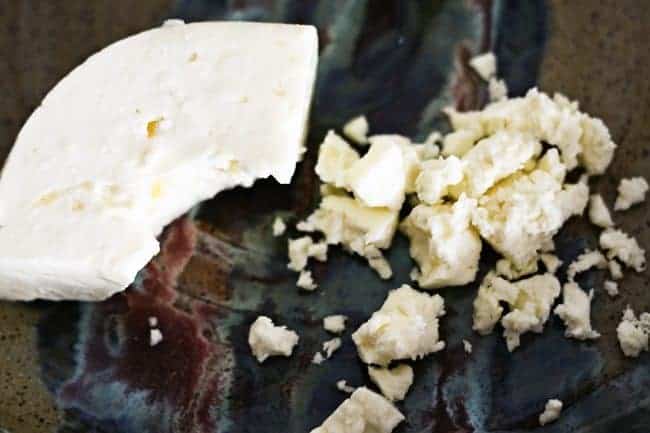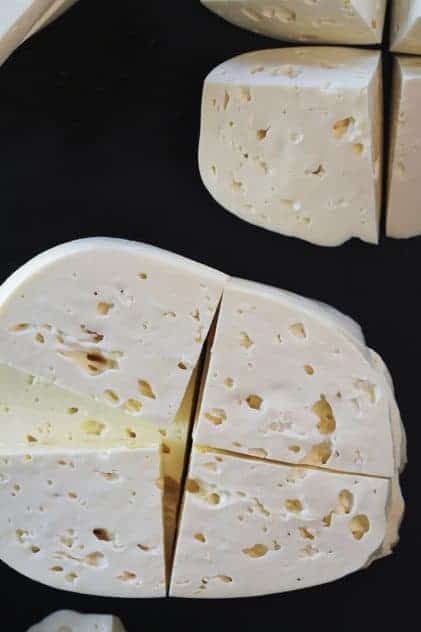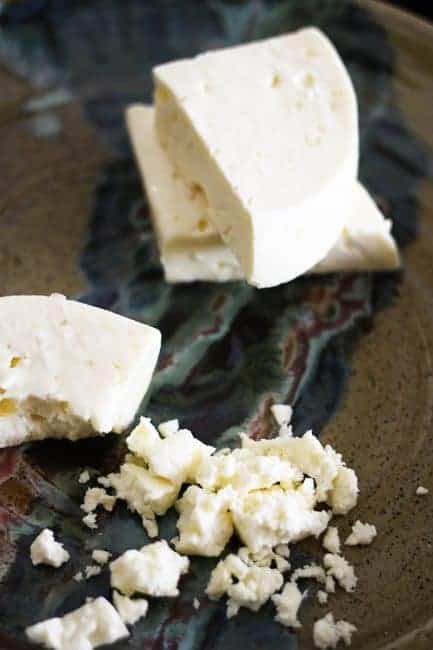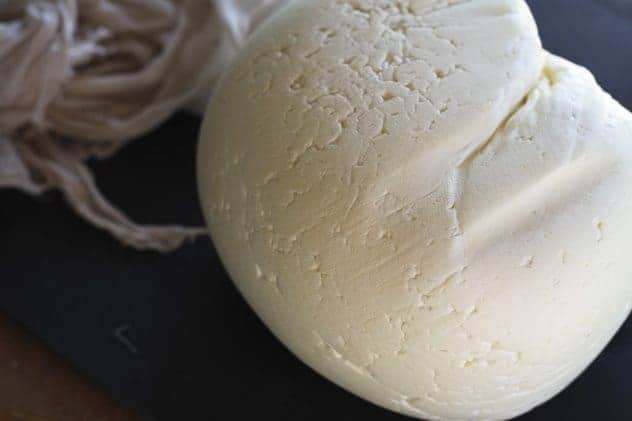I have been promising to bring you my homemade feta cheese recipe for a while (Ahem, probably a couple of years. Eek.) Today is finally the day. You may be wondering why I bother making feta cheese from scratch. The answer-as is often the case- is that homemade tastes great and because I can. I am, after all, the daughter of a man who feels driven to walk laps around the house outside in blizzards when authorities warn that you shouldn’t go out unless you have to do so.
There’s an enormous satisfaction in doing something that seems just undo-able, isn’t there? Not only does homemade feta taste incredible, but it delivers a pioneer, up-by-my-bootstraps joy that a store-bought version just can’t give no matter how wonderful it is.
…But there’s another reason to take the plunge and it’s a doozy. For the cost of three gallons of milk (it can be pasteurized/homogenized or raw, cow or goat milk) and about a dollars worth of other stuff, you get a massive amount of feta cheese. As in a gallon jar of brined feta cheese. If you’re fearful of trying your hand at cheese making, just think of it this way; the risk is about twelve dollars worth of materials (depending on milk cost near you) versus a potential payoff of about forty dollars worth of cheese and an enormous ego boost. If it -bumbum BUM!!!!!- goes wrong, you can feed the errant cheese to dogs, cats, pigs, etc… They’ll be happy.
I’m going to get right into it because even if I’m being succinct, this post is going to be long on account of the how-to photos… There’s no getting around it. Some important notes:
- Stay calm! Cheesemaking is not supposed to be stressful. It may seem complicated, but it isn’t. Just go one step at a time and you’ll get there.
- Don’t get freaked out by the length of time it takes to make this. Much of the time is hands-off time. Another warning for those who haven’t made cheese or fermented something before; it gets a little, um, pungent smelling at times. Keep a-going. Don’t worry! Remember that cheese making is essentially controlling how fast and in what way milk ‘goes bad’. If it goes bad the right way it’s delicious!
- The only special equipment you really need to pull this off is a large stainless steel or other non-reactive pot, a heat source, a long knife or off-set spatula, a colander, something from whence to hang the cheese and butter muslin (extra, super, mega fine cheesecloth.) Do not confuse this with the “fine” cheesecloth you get in the grocery store or hardware store. It’s confusing terminology, but that stuff is so not fine. Just look for something called butter muslin and you’ll be fine. Finer than cheesecloth. Sorry. You can get it here.
- You can opt to use raw OR pasteurized/homogenized milk. It can be cow milk or goat milk. Any of those choices will be delicious.
- Goat milk is naturally more tangy, so if you use cow milk, you may want to consider adding a bit of lipase powder. Lipase is an enzyme that naturally occurs in higher amounts in goat milk. If you want cow milk feta to have that bite that is found in feta, lipase powder is your answer. You can get it via my beloved Amazon.com should you wish to.
- As far as specialty ingredients go, the lipase is optional, but rennet and mesophilic culture are not optional. Again? You can turn to Amazon.com. Here’s one for mesophilic culture.
- Whatever you do, don’t think Junket Rennet will do the job. It simply won’t. That’s for custard making. My preferred cheesemaking rennet is made from animal sources.
- But there is a perfectly acceptable and delicious vegetarian option…
- Finally, I suggest you start the process around lunch time. This gives you the time needed to do the Day One portion of the recipe before too late in the day.
Just think what you’d do with a gallon jar full of fabulous feta cheese. You can go nuts with feta! On pizzas, spanakopita, this tempting salad from my friend, a baked potato, in soup, in omelets, with olives and bread, IN bread, and in just about any recipe that calls for cheese. Where would you use your wealth of feta?

Homemade Feta Cheese | Make Ahead Mondays
Rate RecipeIngredients
For the Cheese:
- 3 gallons fresh raw or pasteurized and homogenized goat or cow milk
- 1/4 teaspoon Mesophilic culture see link in post for source
- 1/4 teaspoon lipase powder if using cow milk Omit for vegetarian cheese. Lipase is animal derived.
- 1 teaspoon single-strength liquid rennet dissolved in 1/2 cup of cool or 1/2 teaspoon double strength liquid OR 3/4 of a vegetarian rennet tablet crushed, UNCHLORINATED water.
- kosher salt no substitute
For the Brine:
- 1/2 cup kosher salt no substitute
- 1 gallon cool UNCHLORINATED water
Instructions
To Make the Cheese:
- Sterilize all of your equipment with boiling water before beginning (including the cheesecloth.)
- In a very large, non-reactive pot, bring all of the milk up to 86°F.-88°F. Add the mesophilic culture and the lipase powder, if you are using it. Stir well with an up and down motion, cover the pot and let rest for one hour. Try to maintain the 86°F temperature. If you have trouble with that, you can set your large pot inside a larger pot with an inch of hot water in the bottom of it. This should help regulate the temperature more gently than firing up a burner directly beneath the milk. The goal is to avoid rapid temperature changes.*See notes.
- After 1 hour, add the dissolved rennet to the milk and stir vigorously for 15-20 seconds. Remove the spoon from the pot, cover it, and let it stand undisturbed for 30-40 minutes or until the curd 'breaks' cleanly when you insert the tip of a knife and lift as shown below.
[img src="https://www.foodiewithfamily.com/wp-content/uploads/2013/01/homemade-feta3.jpg"] - Cut a 1/2-inch grid pattern into the curd. Don't get perfectionist here, you'll get frustrated. The curd likes to move while you try to cut it, so just do your best.
[img src="https://www.foodiewithfamily.com/wp-content/uploads/2013/01/homemade-feta.jpg"] - After you have the grid pattern, hold the knife at a 45° angle and retrace the cuts you've already made. This is going to make MOST of the curd in the pot into roughly 1/2-inch pieces.
[img src="https://www.foodiewithfamily.com/wp-content/uploads/2013/01/feta-in-brine.jpg"] - The ones that didn't get cut that small will break up later in the process. DO NOT STIR THE CURD YET.
- Let the curd rest undisturbed for 10 minutes.
- After 10 minutes, stir gently, breaking up any larger pieces you missed with the knife. Again, don't sweat this too much... Just try to have most pieces in the neighborhood of 1/2 an inch.
- Keep the curd at 86°F to 88°F for 45 minutes, stirring from time to time to keep the curd from sticking to itself. You'll notice the curd getting slightly firmer and smaller. This is because as you stir it and hold it at this temperature it releases more whey.
[img src="https://www.foodiewithfamily.com/wp-content/uploads/2013/01/homemade-feta-1.jpg"] - Dampen your butter muslin/cheesecloth and use it to line a large colander. I usually position the colander over another large stockpot because I like to save the whey for baking.
[img src="https://www.foodiewithfamily.com/wp-content/uploads/2013/01/homemade-feta-2.jpg"] - Carefully and gently ladle the curds and whey into the lined colander.
[img src="https://www.foodiewithfamily.com/wp-content/uploads/2013/01/homemade-feta-4.jpg"] - When all the curds are in the colander, draw all 4 corners of the cheesecloth together to form a bag and tie in a sturdy knot. Hang the bag over the sink or a bowl or pot so it can drain freely.
[img src="https://www.foodiewithfamily.com/wp-content/uploads/2013/01/homemade-feta-5.jpg"] - Let the cheese drain at room temperature for 3-4 hours, carefully lower the bag into the colander and untie the bag. At this point, the cheese will be smooth on the bottom and spiky on top.
[img src="https://www.foodiewithfamily.com/wp-content/uploads/2013/01/homemade-feta-6.jpg"] - Flip the curd over so the spikes are at the bottom, retie and rehang the bag. Let it drain for 24 hours.
Here is where you're going to notice a certain stank coming from the vicinity of your cheese. That's okay. It means you're on the right track. Don't back down!
- After 24 hours, lower the cheese, untie the bag and put the curd onto a sterilized cutting board. Cut it into blocks. I usually aim for pieces that are about the size of a deck of cards but about 2 inches thick.
[img src="https://www.foodiewithfamily.com/wp-content/uploads/2013/01/homemade-feta-9.jpg"] - Generously sprinkle all of the surfaces of the cut cheese with kosher salt then load the cheese into a sterilized, large, food-safe container with a tightly fitting lid.
[img src="https://www.foodiewithfamily.com/wp-content/uploads/2013/01/homemade-feta-10.jpg"] - Let the cheese rest at room temperature (DO NOT REFRIGERATE even though it is counterintuitive.) for 2 to 3 days so that it can continue releasing whey and hardening up. This will help it store longer.
To Prepare the Brine and Store the Cheese:
- Pour the whey the cheese has released into a sterilized large, food-safe container with a tightly fitting lid. Arrange the cheese blocks in it.
- Add the gallon of water and 1/2 cup of kosher salt to a non-reactive pot. Stir well over medium heat until the salt is completely dissolved. Let the brine come to room temperature before pouring it over the cheese. Put the lid in place tightly on the container and store the cheese in the refrigerator.
- Let the cheese age at least two weeks before eating. It is good for up to a year as long as it is kept submerged in the brine and refrigerated. It will continue to get stronger in taste as it ages.
Notes
Nutrition
Nutritional information is an estimate and provided to you as a courtesy. You should calculate the nutritional information with the actual ingredients used in your recipe using your preferred nutrition calculator.
did you make this recipe?
Make sure to tag @foodiewithfam on Instagram and #hashtag it #foodiewithfamily so I can check it out!






Reader's Thoughts...
Jim says
In your blog you said,
“If it -bumbum BUM!!!!!- goes wrong, you can feed the errant cheese to dogs, cats, pigs, etc… They’ll be happy.”.
You shouldn’t feed dogs milk products as it makes them sick.
Rebecca says
We’re going to have to agree to disagree on this. It’s a cultured product (in this case made from raw milk.) I certainly wouldn’t dump it wholesale into the dog dish, but I’m okay with a little nibble here and there and my dogs tolerate it well.
James Hale says
Hello,
I live in a very hot climate (Thailand) and am wondering if I would need to make any adjustments to your recipe due to the heat. I’m visiting my family in the U.S. right now and will bring the supplies back with me. I’m excited to try this as Feta can be quite expensive in Bangkok, but my kitchen can be quite hot and I’m not sure if that will speed up or slow down the whole process. Any suggestions would be appreciated. Thank you!
Rebecca says
It will be quite likely to speed things along a bit, James. I don’t have personal experience with cheese making in that kind of climate, so just keep your eyes and nose on it for the visual and olfactory clues!
Rachel says
First time cheese maker here, but excited to give it a try! Can you skip the brine and marinade the feta with Olive Oil?
Rebecca says
You know what? I’ve never actually tried that! I think I’d be inclined to brine it anyway because it ages nicely. Then I’d probably small-batch marinate in olive oil, but that’s just me. I don’t actually know whether storing it long term in olive oil would work because it tends to solidify in the refrigerator (meaning olive oil does…)
Rachel says
If I brine first then marinade, how long would I let it brine before I make smaller batches to marinade. My goal is to re-create this wonderful marinated feta I bought from the store from Yarra Dairy, garlic and thyme. It was heavenly!
Caz says
I’m really looking forward trying this recipe out but could anyone adjust the quantity for me as I only have 2litres of goats milk and not sure how much other stuff I would use to compensate for the small quantity of mil.k. Any suggestions guys ?????
Rebecca says
Hi Caz- I’m pretty sure you can just scale up and down proportionately. I’d be inclined to freeze the 2 liters and wait until I could lay my hands on enough to make a full batch, though.
Gina says
Hi Rebecca,
Thanks so much for this recipe. I made my first batch of feta a few months ago, and I’m hooked! It’s so much better than store bought, and once you make it a time or two it’s really pretty easy. I’m even selling it at my local green market along with containers of the whey that I end up with. I use raw cow milk from a local dairy with pastured cows. I’m following your recipe pretty much exactly except that I add a little calcium chloride to the brine. It’s helped to keep the cheese a bit firmer. I’m looking forward to trying batches of the cheese that have aged longer. At this point, I haven’t been able to keep it around longer than two weeks! Thanks again!
Gina
Lois says
I have the cheese in a container on counter and salted. It is releasing whey – my question is, do I let it soak in the whey now? or do I remove the whey to reintroduce after the 3 days at room temperature? Thanks.
Rebecca says
You can let it sit in the whey unless the whey starts REALLY building up. If that happens, I’d drain it and keep it in a jar for reintroduction. 🙂
Jess says
So I was wondering…. I am living in a country now where the fresh milk is not considered safe and therefore only have access to UHT milk. Can it be done with this, or am I just dreaming at something that is never going to happen…. Would appreciate any advice. I am going to have fabulous cheese dreams tonight!
Rebecca says
I am so sorry, but I think UHT will not work. The ultra high temp at which its processes destroys the milk day’s ability to “coagulate” when the rennet is introduced. You’d get the tiniest grains possible.
Jeanette says
Can I use coarse salt instead of kosher? I live in a remote area and the general store doesn’t sell kosher salt.
Thanks!
Rebecca says
You can but only if it doesn’t have iodine or other additives. The beauty of kosher salt is that it is pure. Iodine will wreck the cheese! (Amazon has a good deal on kosher salt if it comes down to it!)
Michael says
Hi Rebecca, Thanks for sharing the recipe. I have a question? DOes your cheese tasye like the Feta that we buy at the store. My Aunt made some, based on your recipe and it had no taste? What are we doing wrong? Please adbise at your convenience. Thanks,
Rebecca says
Hi Michael, every batch of cheese is going to be a bit different because every batch of milk is a little different. The homemade stuff is usually a bit milder to begin with but becomes quite sharp when aged. Also, did you mom use lipase powder? If she’s finding it a bit too mild for her taste, she can age it or make another batch with more lipase in it. Lipase is what helps the feta pack a punch when it’s young.
Michael says
Thanks. I appreciate the uick response. We’ll try it again. Have a great weekend.
Susan Kennedy says
I am on day two of my second batch of your feta recipe. My first batch was met with rave reviews for die hard feta lovers. I use raw jersey milk from our family cows. Thanks so much for this no fuss east to follow approach to feta cheese making!
Bruno says
The recipe is good, but it is STENCH, not stank
Rebecca says
You say tomato, I say tomahto, Bruno 🙂 It surely does smell foul, doesn’t it?
Donnell says
Hi there. I made your recipe a couple of days ago and I’m just wondering if you cover the feta up when it’s hardening up for the 2-3 days? Thanks!! 🙂
Emma says
This is awesome! Can you culture bad bacteria???
Mine went really crumbly after the draining stage, did I let it get too dry?
Rebecca says
Hmmmm… smell it and if it smells like feta, taste it! I bet you can’t brine it if it’s crumbly, but I think you could still freeze it!
Eva | Adventures in Cooking says
Yayyyyy! I am SO happy you told me about this! After all that talk about yeast anxiety, I think this guide will cure my feta anxiety. And even if I mess up again and it turns into chèvre, that’s not necessarily a bad thing. I will let you know how it comes out when I try it, which may not be for a bit since I need to go on a cheesecloth run and sometimes lack the motivation to un errands after work, but this WILL happen!
Also, your photos are so pretty!!! I love all the grilled sandwich/burger ones with the nice crisp on the outside of the patty, makes me want to dust off our grill and start using it again now that the weather’s warmed up 🙂
Rebecca says
You said it, Eva! One way or the other, you end up with cheese and that can’t be bad, right? 😀
Stef says
This is exactly what I have been looking for! My question is, is there are large difference in flavor between goat milk and cows milk? I love tangy feta – not so salty – and my memories of feta in Greece is the tang. Of course my favored way to eat it is a rustic (out of Athens) taverna feta served on top of slightly acidic tomatoes, red onions, kalamta olives, oregano, red pepper flakes, drizzled with EVOO and a loaf of REAL bread to sop up the wonderful juices! With a great bottle of retsina to wash it down. And then, of course, a siesta.
Rebecca says
Okay,Stef, here’s the score. Yes, there is a large difference between goat and cow’s milk. Goat milk naturally has more lipase to it, so it’s much tangier and funkier. Cow’s milk is much more mild. You can mitigate that some with added lipase, but I think the goat feta is always going to be zippier. This is relatively salty on account of the brine, so if you don’t want it to be too salty, you may want to rinse it post aging and then freeze rather than brine it. 🙂
Harry says
Does anyone know how many ounces of cheese this recipe makes?
Rebecca says
Hey Harry… I can’t really estimate because its going to depend on the milk itself! Batches can vary wildly… One general rule of thumb is that each gallon of milk yields in the neighborhood of a pound of cheese, but that can be off by a few ounces… 🙂
Cassie | Bake Your Day says
Will you come over to my house and give me a personal lesson on this. I absolutely love it! You are talented, my friend!
Katie says
Rebecca- this post might have saved my life for the next 2 years!! We are living in Paraguay and they have no feta. So this is going to be my next project. I have NEVER made any kind of cheese, and I am a stick exactly to the recipe kinda girl (to a fault)! I found everything I need on Amazon, but the shipping is more than the product on a few things, which is annoying. So I tried to find rennet and mesophilic from other places, but am weary to buy something that is not exactly what you used since I know nothing about those products. Any thing you can recommend, or should I just fork over the $25to ship those two things?
Sara says
Hi, Rebecca… thank you for your post! I have never ventured into cheesemaking, but you make me want to try it.
Here’s the thing: I am kind of paranoid about food spoilage. I know that cheese is all about directing spoilage in the right way, but I still feel very hesitant. How will I know if my stank is the right stank? Why will this cheese keep for up to a year when I find that feta from the store spoils (REALLY spoils) within a few weeks of opening it? If you or anyone reading can reassure me at all, I would appreciate it so much. Let’s get real: should I just buy my feta?
P~ says
I made the feta. It is just wonderful! Really, thank you so much for posting this process. I had wanted to make feta, but my cheese making book made it seem intimidating; you made it seem simple. And it was! I’ll never buy feta again. P~